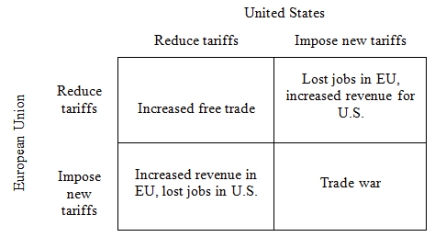Free Trade Game
Free trade occurs when goods and services between countries flow unhindered by government-imposed restrictions such as tariffs, quotas, and antidumping laws that are often designed to protect domestic industries. Although it is well known that free trade creates winners and losers, a broad consensus exists among most economists that free trade has a large and unambiguous net gain for society as a whole. For example, Robert Whaples (2006) finds in a survey of economists that "87.5% agree that the U.S. should eliminate remaining tariffs and other barriers to trade" and that "90.1% disagree with the suggestion that the U.S. should restrict employers from outsourcing work to foreign countries." Despite this consensus, it is not at all clear that countries will actually adopt policies promoting free trade.
Consider the following strategic situation in which the United States and the European Union (EU) are engaged in trade negotiations. Both countries must decide whether to reduce their tariffs or impose new tariffs. The best outcome for both countries is for them to impose new tariffs and for the other side to reduce tariffs; they could then export more easily to the other country and they would obtain increased revenue from the new tariffs. The worst outcome for both countries is for them to reduce tariffs and for the other country to increase tariffs; they would lose jobs as a result of reduced exports and the other country would benefit from their lower tariffs. Of the remaining two outcomes, both countries prefer the outcome in which they reduce tariffs to the one in which they both impose new tariffs. If both countries reduce their tariffs, then each country can benefit from increased free trade. If both countries impose new tariffs, there is a trade war in which each country sees a decline in trade and a loss of jobs. Based on this story, the preference ordering for the EU over the four possible outcomes is:
• Impose; Reduce > ; Reduce > Impose; Impose > Reduce; Impose.
And the preference ordering for the United States is:
• Reduce; Impose > Reduce; Reduce > Impose; Impose > Impose; Reduce,
where the EU's action is given first, the United States' action is given second, and ">" means "is strictly preferred to."
Using the ordinal preferences (4, 3, 2, 1) to capture these preference orderings, fill in the empty payoff matrix. Based on the preference orderings in the Free Trade Game.
Figure 1: Free Trade Game

-Does the European Union have a dominant strategy in the Free Trade Game?
Definitions:
World War I
A global conflict that lasted from 1914 to 1918, involving many of the world's great powers and marking significant political, military, and social changes.
André Derain
A French artist and co-founder of Fauvism with Henri Matisse, known for his bold colors and innovative brushwork.
Brush Strokes
The application of paint onto a surface with a brush, creating distinct textures and dynamics in painting.
Nazi Bombing
Refers to air raids and bombings conducted by Germany during World War II, targeting military and civilian areas in various countries.
Q1: The Value Management Strategy Map identifies all
Q2: Marketers can interrupt the stages of the
Q6: The term used to describe a clear,
Q9: A distribution channel can be depicted as
Q11: If we found evidence that economic development
Q15: The goal of an MVMS is to
Q28: Nonpermissive electoral systems (such as single-member district
Q41: What is the subgame perfect Nash equilibrium?<br>A)
Q43: If the Regime believes that the Religious
Q46: Portugal, Spain, and Greece experienced transitions to